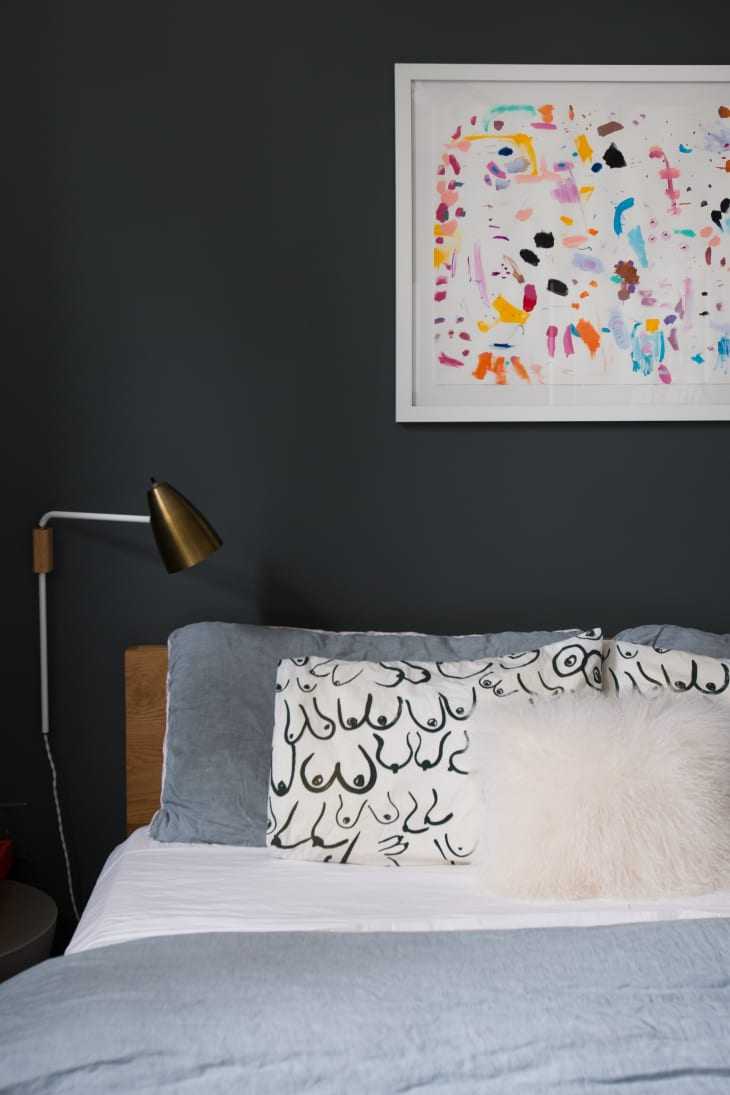The one place I’ve been seeing a lot of color lately is in bedrooms, and things are getting dark. Navy and midnight blues, charcoal grays, deep teals, and even black, which is the trickiest to pull off if you don’t get a lot of natural light in your space. But it’s doable. The word on the street is that this trend might actually be beneficial for sleep—either it helps you drift off easily and/or stay asleep longer. And that’s because darkness, or lack of light, is key for melatonin production.
What’s less clear, however, is whether wall color or bedding color, for that matter—has any bearing on said melatonin production. My guess is that it can’t hurt, but I talked to a few pros to get their take on dark bedrooms and whether they’re actually beneficial for catching zzz’s or not.
Pros
Dark Bedrooms are Calming Because They’re Less Energetic

“What’s causing the calm feeling is not necessarily the hue, but rather the absence of white,” says designer and feng shui expert Aubrey Thorne . “White reflects light, and black absorbs light. So when lighter colors bounce light around a room, there is literally more activity in a lighter space.” Because darker colors reflect less light, darker rooms are less active and therefore more restful. “Our bodies and brains are wired to respond to differing light levels and don’t register the biological difference between dark charcoal walls and the night sky,” says Thorne. “Color absolutely affects our biorhythms, thus mood, thoughts and behaviors.”
The Contrast Can be Good at Night
White and gray walls have dominated design for the last couple of years. So chances are, your main rooms are probably light and bright. People tend to get a little riskier in their bedroom design schemes since they’re private spaces, generally off view from the public. And if you choose something on the darker side for the bedroom, the difference between this space and the rest of your house could help you achieve those sleepytime vibes when you retire to your room for the night. “Our bedroom has so much contrast from the rest of the house that you come in and can’t help but feel like you’ve entered a new place—a haven,” says blogger and DIYer Zoe Hunt . “Overall, adding such a deep blue to our space has made it most restful and refreshing.”
Deep Colors are Strong
Clutter can be a cause of anxiety and stress for a lot of people, and that can lead to sleeplessness. Thing is, when you go bold with wall color, you don’t need a lot of other decorative bells and whistles. So by the transitive property, deep walls means less clutter and stress, and as a consequence, more sleep. “Deep colored walls are a statement in itself, so you can put aside all the clutter and excess decor and enjoy simplicity without sacrificing style,” says Hunt.
But then there’s the other side of the coin. Can a wall color really elicit a Pavlovian response of sleepiness? Some designers aren’t so sure.
Cons
If the Lights are Out, Does Wall Color Matter?
“When correlating color to sleep, it becomes tricky because no matter what the color of your room is, when you turn out the lights and it’s dark outside, the walls and colors don’t really matter all too much,” says designers Kenneth Boyer and Kristin Gunnette of Atelier k . “Instead, we suggest focusing more on the investment of blackout shades or blinds in a bedroom rather than dark walls. This way, you can still have a calming environment during the day, while being able to easily fall asleep during the evening.” Fair point.
Bedrooms Aren’t Just for Sleeping
“We feel that a bedroom paint or primary color should be something that a client not only finds soothing as they fall asleep at night but as they wake up in the morning too,” says Meghan Hackett-Cassidy and Erin Hackett of Hackett Interiors . “While it may make sense that a dark color could be conducive to falling asleep, it may not create the best environment for waking up. That’s part of the reason this design duo sticks to soft neutral colors that are easy on the eyes and create that spa-like oasis feel. “This, to us, is the ultimate goal when designing bedrooms, as it is the space you go to every night to unwind and relax,” adds Hackett-Cassidy and Hackett. Fair enough.
Turns out designers are split into two camps on dark bedrooms. My feeling is that it can’t hurt to go to the dark side, but if you want a lighter wall color, that’s probably okay too—provided you have good blackout shades!

Leave a Reply